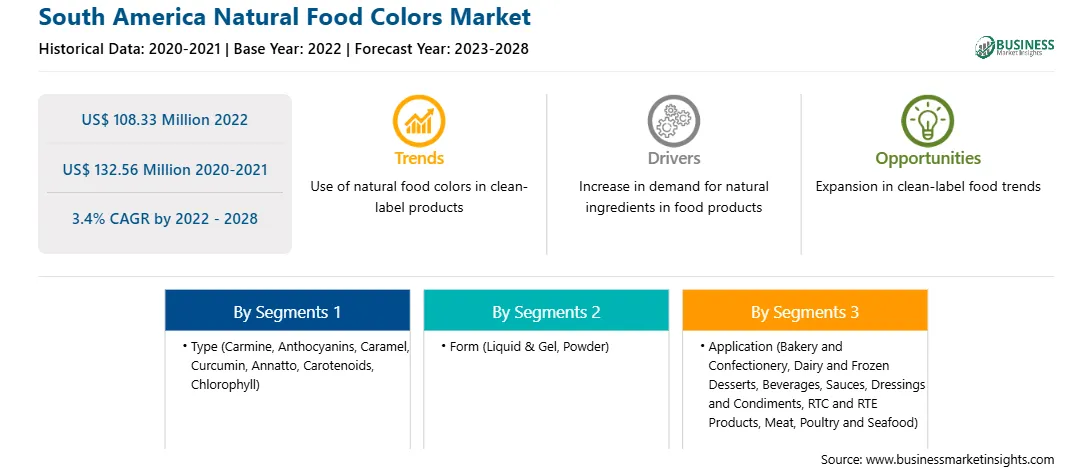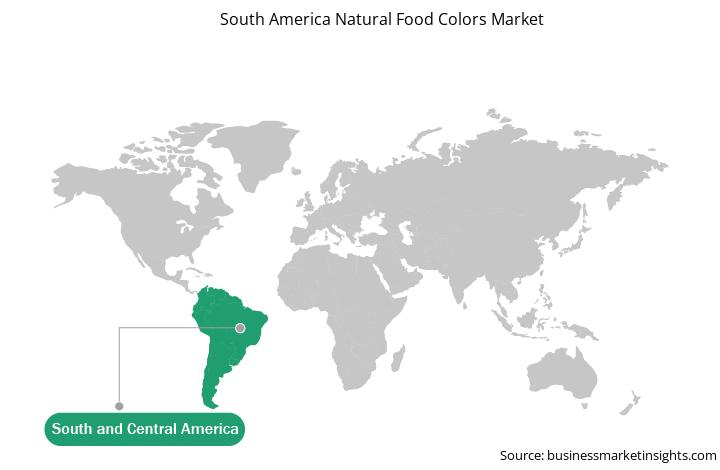The natural food colors market in SAM is expected to grow from US$ 108.33 million in 2022 to US$ 132.56 million by 2028. It is estimated to grow at a CAGR of 3.4% from 2022 to 2028.
Increasing Consumer Proclivity Towards Clean Label Products
Many people believe that food and beverage products are healthier only when they have a label with recognizable ingredients. The food and beverage industry has entered a phase of clean label products, which has led manufacturers to adopt natural food colors in order to gain a competitive edge. Clean label products also attract more number of customers, as they are more comfortable in consuming products with known ingredients. Other factors such as increasing health awareness and increasing spending power of consumers have also created a rise in food with natural ingredients and clean label products. According to Clean Label Alliance, a minimum of 75% people are ready to pay high prices for clean label products. This can be attributed to the fact that these products are minimally processed, eco-friendly and organic. The market for natural food colors is expected to grow during the forecast period, as there has been a constantly growing consumer preference for clean label products. Consumers proclivity towards clean labelled products are rising due to the rise in health awareness and food adulteration. This results in consumers looking to the labels before purchasing any products. This factor is expected to be a crucial driver for the demand growth of natural food colors.
Market Overview
According to Natural Food Colors Food Association (NATCOL), the consumer request for natural solutions and products containing natural colorants in SAM was 57 % in 2019-2020. Annatto color is derived from annatto seeds, which are grown extensively in tropical countries such as Brazil, Peru, or Ecuador. Latin America produces 60 % of total world production of annatto seeds. According to Peruvian Embassy to the UK, Peru has a 95 % share of the international carmine production market. In past few decades, SAM has witnessed shift in overall beverage consumption patterns, along with the growth of food processing industry in parallel with the expansion of supermarkets. These factors have provided consumers with variety of choices for dairy beverages and soft drinks. PepsiCo, Inc. expanded its presence in Mexico and constructed a production plant in Guanajuato. This increasing demand of soft drinks, rapid expansion of beverage industry, and rising awareness of health hazards of food additives are anticipated to fuel the natural food colors market in SAM.
Strategic insights for the South America Natural Food Colors provides data-driven analysis of the industry landscape, including current trends, key players, and regional nuances. These insights offer actionable recommendations, enabling readers to differentiate themselves from competitors by identifying untapped segments or developing unique value propositions. Leveraging data analytics, these insights help industry players anticipate the market shifts, whether investors, manufacturers, or other stakeholders. A future-oriented perspective is essential, helping stakeholders anticipate market shifts and position themselves for long-term success in this dynamic region. Ultimately, effective strategic insights empower readers to make informed decisions that drive profitability and achieve their business objectives within the market. The geographic scope of the South America Natural Food Colors refers to the specific areas in which a business operates and competes. Understanding local distinctions, such as diverse consumer preferences (e.g., demand for specific plug types or battery backup durations), varying economic conditions, and regulatory environments, is crucial for tailoring strategies to specific markets. Businesses can expand their reach by identifying underserved areas or adapting their offerings to meet local demands. A clear market focus allows for more effective resource allocation, targeted marketing campaigns, and better positioning against local competitors, ultimately driving growth in those targeted areas.South America Natural Food Colors Strategic Insights

South America Natural Food Colors Report Scope
Report Attribute
Details
Market size in 2022
US$ 108.33 Million
Market Size by 2028
US$ 132.56 Million
Global CAGR (2022 - 2028)
3.4%
Historical Data
2020-2021
Forecast period
2023-2028
Segments Covered
By Type
By Form
By Application
Regions and Countries Covered
South and Central America
Market leaders and key company profiles
South America Natural Food Colors Regional Insights

SAM Natural Food Colors Market Segmentation
The SAM natural food colors market is segmented into type, form, application, and country. Based on type, the market is segmented into carmine, anthocyanins, caramel, curcumin, annatto, carotenoids, chlorophyll, and others. The carotenoids segment registered the largest market share in 2022.
Based on form, the SAM natural food colors market is segmented into liquid & gel and powder. The liquid & gel segment registered a larger market share in 2022.
Based on application, the SAM natural food colors market is segmented into bakery and confectionery, dairy and frozen desserts, beverages, sauces, dressings, and condiments, RTC and RTE products, meat, poultry and seafood, and others. The beverages segment registered the largest market share in 2022.
Based on country, the market is segmented into Brazil, Argentina, and the Rest of SAM. Brazil dominated the market share in 2022.
Archer Daniels Midland Company, BASF SE, Döhler Group, DuPont, Givaudan S.A., Koninklijke DSM N.V., Naturex S.A., Oterra A/S, and Sensient Technologies Corporation are the leading companies operating in the natural food colors market in the region.
The South America Natural Food Colors Market is valued at US$ 108.33 Million in 2022, it is projected to reach US$ 132.56 Million by 2028.
As per our report South America Natural Food Colors Market, the market size is valued at US$ 108.33 Million in 2022, projecting it to reach US$ 132.56 Million by 2028. This translates to a CAGR of approximately 3.4% during the forecast period.
The South America Natural Food Colors Market report typically cover these key segments-
The historic period, base year, and forecast period can vary slightly depending on the specific market research report. However, for the South America Natural Food Colors Market report:
The South America Natural Food Colors Market is populated by several key players, each contributing to its growth and innovation. Some of the major players include:
The South America Natural Food Colors Market report is valuable for diverse stakeholders, including:
Essentially, anyone involved in or considering involvement in the South America Natural Food Colors Market value chain can benefit from the information contained in a comprehensive market report.